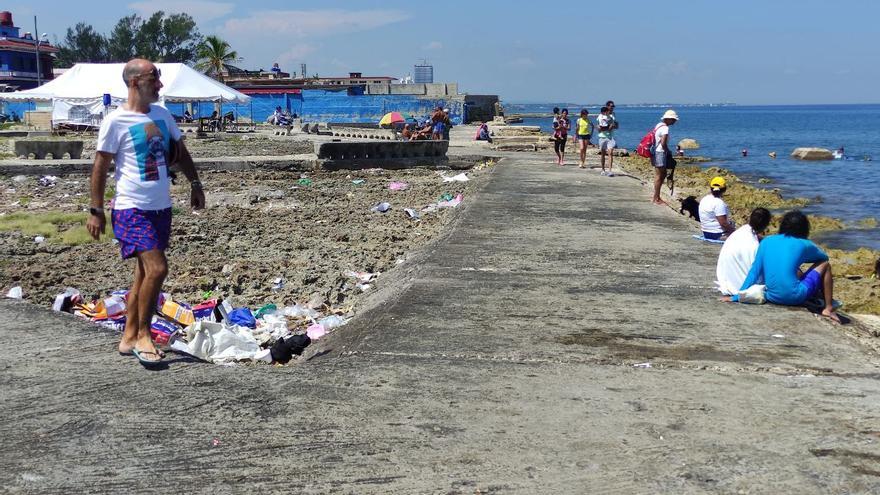
![]() 14ymedio, Juan Diego Rodríguez, Havana, 16 August 2022 — “Don’t take off your shoes!” a mother yelled, this Monday morning, to her newly arrived son at Playita 16, a piece of coastline west of Havana that serves as consolation for those who cannot afford a trip to the white sands of Santa María del Mar or Boca Ciega, in the eastern part of the city. The precaution of keeping his shoes on is not only because of the sharp rocky stretch that appears before reaching the water, but also because of the garbage that fills the area, bottle tops, empty cans, paper and other waste.
14ymedio, Juan Diego Rodríguez, Havana, 16 August 2022 — “Don’t take off your shoes!” a mother yelled, this Monday morning, to her newly arrived son at Playita 16, a piece of coastline west of Havana that serves as consolation for those who cannot afford a trip to the white sands of Santa María del Mar or Boca Ciega, in the eastern part of the city. The precaution of keeping his shoes on is not only because of the sharp rocky stretch that appears before reaching the water, but also because of the garbage that fills the area, bottle tops, empty cans, paper and other waste.
An employee wipes a damp cloth over the counter of a coffee shop a few meters from the waves. There are barely a couple of customers in the place because, despite the heat, the high prices for beer and soft drinks scare away thirsty bathers. A young man asks the woman if the Comunales company — the public services provider — ever goes through the place to collect garbage. “Ah, I don’t know. This is my little piece and it’s clean,” she replies as she shrugs. Outside, the heap of varied packaging covers the ground, gleaming in the August sun.
La Playita 16 has never been a spot that is well cared for by the authorities. Rather, it is a vexing place where, in the ’70s, hippies, rockers and all kinds of people considered “uncomfortable” by the Cuban power structure and its desire to “parameterize” any hint of diversity, congregated. In that piece of coast in the municipality of Playa, the police were fattening themselves by issuing fines and taking away the long-haired youths. Also from there, innumerable and rustic boats departed during the 1994 Balseros [Rafters] Crisis.
Then, at the end of the last century, dollarization began to change the face of this coastline lacking sand and umbrellas. The appearance of several kiosks selling drinks and food attracted other visitors who alternated looking at the sunset with a cold drink or a slice of pizza. Perhaps from those years there are still some more gentrified bathers who parade their bathing suits, their colorful towels and their purebred dogs around the place, but they are few. Most of them have migrated from the beach or the country.
This Monday, almost at noon, despite the harshness of El Indio and his arrows, a drunk who spent the night on the concrete road continued to snore. Some children frolicked on the shore and a lady watched the horizon from under the protection of a huge hat. Around them, the torn bags, some tetrapack boxes that once contained juices or small doses of Planchao rum, and the empty bottles were also part of the scene.
A piece of cardboard flew from a nearby bench to land on one of the waste piles, right next to a couple with a baby stroller who were taking a photo with the little one’s red cheeks in the foreground, behind the already blue sea, and to the side was the motley mountain of debris.
____________
COLLABORATE WITH OUR WORK: The 14ymedio team is committed to practicing serious journalism that reflects Cuba’s reality in all its depth. Thank you for joining us on this long journey. We invite you to continue supporting us by becoming a member of 14ymedio now. Together we can continue transforming journalism in Cuba.
